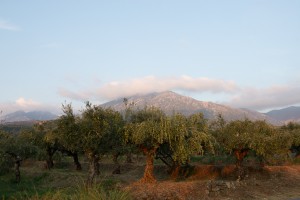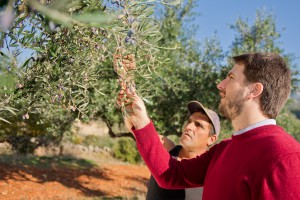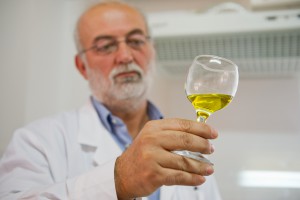What are the quality characteristics of good olive oil?
1.12.2016While in northern Europe the leaves fall from the trees, olive harvest is taking place in the south of Greece. What really matters and how we ensure the best quality for our Mani Bläuel olive oils can be found in this “travel report” along the production chain:
As always, everything starts with the origin – the fruit – the variety, the cultivation area, the pruning of the tree and the right maturity level are the basis of every high-quality olive oil. Starting from the harvest, however, there are numerous more influences which affect the quality of the oil e.g. transport, processing and packaging.
The best conditions in the olive grove

Our tour begins in the southern part of Greece. Here grows the Koroneiki olive from which one of the best oils in the world is extracted. The combination of high light intensity and duration of sunshine, a few hours of rain and a stone and mineral rich mountain soil near the sea offer the best conditions for olive cultivation. Due to the organic method of cultivation the soil remains fertile. In addition, the naturally growing vegetation of legumes and wild herbs makes artificial irrigation and pesticides superfluous.

Careful processing in the oil mill
Immediately after the harvest the journey continues to the oil mill. Short transport distances and careful storage ensure that the olives remain intact. The oil must be extracted within 24 hours at a maximum temperature of 27 degrees Celsius so that the valuable ingredients of the olive remain intact. Bottling in dark glass bottles ensures that the oil is protected against UV radiation. Furthermore, our two agricultural engineers ensure the continuous quality assurance during cultivation and extraction.
The oil that re aches our enterprise comes from long-time co-operation partners and in addition each batch is being checked before acceptance in our lab. Only if the quality profile meets our high requirements, the olive oil is bottled. The Mani Bläuel guidelines exceed the legal requirements by far. According to the EU guideline an olive oil is allowed to be declared as extra virgin – the highest quality class – when the acidity is below 0.8% and the peroxide number is not higher than 20 meqO2/kg. All Mani Bläuel oils have a free fatty acid content of less than 0.4% and a peroxide number of less than 10 to 12 meqO2/kg after 12 months of storage. The lower the value, the fresher the taste.
aches our enterprise comes from long-time co-operation partners and in addition each batch is being checked before acceptance in our lab. Only if the quality profile meets our high requirements, the olive oil is bottled. The Mani Bläuel guidelines exceed the legal requirements by far. According to the EU guideline an olive oil is allowed to be declared as extra virgin – the highest quality class – when the acidity is below 0.8% and the peroxide number is not higher than 20 meqO2/kg. All Mani Bläuel oils have a free fatty acid content of less than 0.4% and a peroxide number of less than 10 to 12 meqO2/kg after 12 months of storage. The lower the value, the fresher the taste.
Before the olive oil leaves our factory, it goes through an internal quality inspection. At regular intervals, the quality is additionally checked and confirmed by external experts and labs. The entire production process is also supported by a research group at the University of Udine in Italy in order to continuously improve quality standards along the supply chain. This cooperation is a significant investment in our product and in research.
Detailed labelling in the trade
The olive oil has now reached the retail segment. Some indications on the label can help the consumer to detect high quality olive oil:
- Only products of highest quality belong to the category extra virgin.
- The quality seal “PDO” stands for Protected Designation of Origin and ensures that the olives come from a certain region. As with our Kalamata PDO olive oil or Cretan olive oil Messara PDO.
- The organic label assures that the olive oil is from controlled organic cultivation.
- The Naturland Fair seal guarantees fair conditions along the entire value chain.
